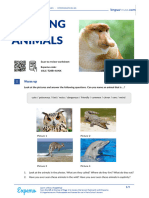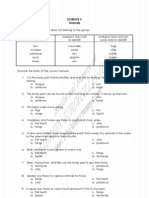Playing Hide and Seek: Warm-Up
Playing Hide and Seek: Warm-Up
Uploaded by
rigodimariana76Copyright:
Available Formats
Playing Hide and Seek: Warm-Up
Playing Hide and Seek: Warm-Up
Uploaded by
rigodimariana76Original Title
Copyright
Available Formats
Share this document
Did you find this document useful?
Is this content inappropriate?
Copyright:
Available Formats
Playing Hide and Seek: Warm-Up
Playing Hide and Seek: Warm-Up
Uploaded by
rigodimariana76Copyright:
Available Formats
HEAAADERLOGORIGHT
ENGLISH FOR TEENAGERS · GENERAL ISSUES · PRE-INTERMEDIATE (A2-B1)
PLAYING
HIDE AND
SEEK
QrrkoD Scan to review worksheet
Expemo code:
1BLU-92MD-HK2L
1 Warm-up
Think of things that plants and animals have in common and things that make them different. Match
the options with the correct group.
A: reproduce/create new G: move around to find food
plants or animals
B: stay in one place H: create seeds
C: develop new plants from I: have muscles, eyes, mouths,
their parts ears, etc.
D: produce their own food J: need a source of energy or
food
E: are living things K: grow and die
F: eat other living things L: create eggs or give birth
both animals and plants only plants only animals
FOOOOTERRIGHT Learn without forgetting! 1/10
Scan the QR at the top of Page 1 to review the lesson flashcards with Expemo.
© Linguahouse.com. Photocopiable and licensed for use in Aline Silva's lessons.
HEAAADERLOGORIGHT
PRE-INTERMEDIATE (A2-B1)
PLAYING HIDE AND SEEK
2 Animal or plant?
Part A: Look at the photos and decide if you see an animal or a plant.
a. b. c. d.
e. f. g. h.
Part B: Match the descriptions to the photos.
1. Corals look like colorful plants or little trees. They live in big groups, or colonies, attached to the
ocean bottom. They don’t move around at all.
2. The fly orchid is a flower that looks like a fly.
3. Walking leaves are insects that look like leaves. People often keep them as pets.
4. The orchid mantis is an insect that looks like a flower. When other insects land on it, the mantis
catches and eats them.
5. Sea anemones look like flowers attached to the sea bottom. They eat small fish.
6. Sea cucumbers live in the oceans. There are as many as 1,250 species and some look like
cucumbers.
7. The Venus flytrap is a plant which eats insects. It has two big leaves with a kind of ‘teeth’ that can
shut in half a second to trap an insect inside.
8. Stick insects are insects that look like sticks. They eat leaves. They look like that to hide from
predators.
Glossary:
attached – fixed to something
trap – catch and keep inside
FOOOOTERLEFT Learn without forgetting! 2/10
Scan the QR at the top of Page 1 to review the lesson flashcards with Expemo.
© Linguahouse.com. Photocopiable and licensed for use in Aline Silva's lessons.
HEAAADERLOGORIGHT
PRE-INTERMEDIATE (A2-B1)
PLAYING HIDE AND SEEK
3 Predator or prey?
Part A: Which of the animals in the list are predators?
anemones bees cats dogs
earthworms gazelles koalas lions
llamas orchid mantises pandas penguins
rabbits walking sticks wolves zebras
Part B: Match the predators to their typical prey.
1. crows a. gazelles, zebras
2. penguins b. mosquitoes
3. lions c. fish
4. frogs d. earthworms
5. snakes e. birds, frogs, mice
6. bats f. flies, snails
4 Use your brain
Part A: Give two examples of how animals escape their predators. Use the pictures below to help
you.
Part B: Give two examples of how predators manage to catch their prey.
FOOOOTERRIGHT Learn without forgetting! 3/10
Scan the QR at the top of Page 1 to review the lesson flashcards with Expemo.
© Linguahouse.com. Photocopiable and licensed for use in Aline Silva's lessons.
HEAAADERLOGORIGHT
PRE-INTERMEDIATE (A2-B1)
PLAYING HIDE AND SEEK
5 To eat or to be eaten?
Read the text and complete the gaps with the verbs. Then listen to the recording and check your
answers.
attack chase defend escape fight
hide hunt pretend protect trap
Predators eat other animals. They use a variety of skills and methods to catch, kill and eat their prey.
Cats spend a lot of time looking for something to eat. When they find it, they can patiently wait for
a mouse to leave its hiding place. They can sit still for a long time to make sure the bird doesn’t see
1
them before they are ready to it. Most birds are too fast for the cat and manage
2
to . That’s why you find more dead mice on your doorstep than dead birds. Lions
3
choose their prey carefully. They usually weak or sick animals. They don’t want to
4 5
with a strong zebra or gazelle that can itself using its hard hooves.
6 7
Spiders don’t use speed or strength when they ; they insects in their
webs, instead. This is what predator plants like the Venus flytrap do as well. Prey animals use a lot of
ways to protect 8 themselves. They 9
, run in zig zags, and 10
to be
dead.
FOOOOTERLEFT Learn without forgetting! 4/10
Scan the QR at the top of Page 1 to review the lesson flashcards with Expemo.
© Linguahouse.com. Photocopiable and licensed for use in Aline Silva's lessons.
HEAAADERLOGORIGHT
PRE-INTERMEDIATE (A2-B1)
PLAYING HIDE AND SEEK
6 Masters of camouflage
Part A: What is this animal’s name? What is it famous for?
Part B: You are going to watch a video and complete the notes with one or two words. Read the notes
carefully and try to predict the answers before watching.
What is camouflage?
1
Both predators and prey don’t want to be .
2 3
They hide by using , patterns, or by trying to look like other
4
or .
Looking like the things around you is called camouflage.
Looking like other things is called mimesis or mimicry.
Examples
5
The matches the color of the moss.
6
The crab spider matches the color of the .
7 8
The leopard, the and the sea turtle use to hide.
9 10
The leafy looks like seaweed, the octopus can look like a group of ,
and the leaf-tail gecko can look like a tree trunk or a twig.
leafy sea dragon crab spider leaf-tailed gecko
FOOOOTERRIGHT Learn without forgetting! 5/10
Scan the QR at the top of Page 1 to review the lesson flashcards with Expemo.
© Linguahouse.com. Photocopiable and licensed for use in Aline Silva's lessons.
HEAAADERLOGORIGHT
PRE-INTERMEDIATE (A2-B1)
PLAYING HIDE AND SEEK
Part C: Replace the words in bold in the sentences using the words and phrases from the list. Then
watch the video again and check your answers.
detected disguise themselves harmless herd imitate
inedible outline poisonous serve as surroundings
1. Many animals hide by trying to look like something else. →
2. They do this because they don’t want to be seen. →
3. They want their looks to match the things around them. →
4. Some try to look like other objects or animals. →
5. Patterns matching the surroundings make it difficult to see the shape of the animal. →
6. Zebras’ stripes aren’t used as camouflage only. →
7. A group of zebras can recognize each other by their stripes. →
8. Some animals pretend to be dangerous to eat. →
9. Other animals pretend they are not nice to eat. →
10. Insects think that orchid mantises are not dangerous. →
FOOOOTERLEFT Learn without forgetting! 6/10
Scan the QR at the top of Page 1 to review the lesson flashcards with Expemo.
© Linguahouse.com. Photocopiable and licensed for use in Aline Silva's lessons.
HEAAADERLOGORIGHT
PRE-INTERMEDIATE (A2-B1)
PLAYING HIDE AND SEEK
7 Language focus: plural forms
Part A: Label the pictures using singular forms.
1. 2. 3.
4. 5. 6.
7. 8. 9.
FOOOOTERRIGHT Learn without forgetting! 7/10
Scan the QR at the top of Page 1 to review the lesson flashcards with Expemo.
© Linguahouse.com. Photocopiable and licensed for use in Aline Silva's lessons.
HEAAADERLOGORIGHT
PRE-INTERMEDIATE (A2-B1)
PLAYING HIDE AND SEEK
Part B: Write the plural forms of the nouns and then add them to the correct groups in the table
below.
1. an albatross → 8. a kangaroo →
2. a child →
9. a monkey →
3. a city →
4. a country → 10. a man →
5. a fish →
11. an octopus →
6. a foot →
7. a hoof → 12. a tooth →
Countable nouns have singular and plural forms. The plural forms are made by adding the
ending –s or –es, but there are some irregular plural forms, too.
Group A Group B Group C Group D
Most nouns form Some nouns add Some nouns change Some nouns have
their plural form by –es. their spelling when irregular plural
adding the ending the plural ending is forms.
–s to the singular added.
form.
a duck – ducks an ostrich – a fly – flies a mouse – mice
ostriches
a snake - snakes a mantis – mantises a wolf - wolves a goose – geese
a mosquito – a sheep - sheep
mosquitoes
Some nouns ending in –o can be used with –s or –es, e.g. mosquitos/mosquitoes,
volcanos/volcanoes, but some use only one form, e.g. potatoes, tomatoes, heroes, pianos,
zeros. Be careful with nouns ending in – o.
FOOOOTERLEFT Learn without forgetting! 8/10
Scan the QR at the top of Page 1 to review the lesson flashcards with Expemo.
© Linguahouse.com. Photocopiable and licensed for use in Aline Silva's lessons.
HEAAADERLOGORIGHT
PRE-INTERMEDIATE (A2-B1)
PLAYING HIDE AND SEEK
8 Optional extension: singular or plural?
Choose the correct form in each sentence.
1. The orchid mantis eat /eats insects.
2. The leaves look /looks like flowers.
3. This sheep is /are six years old.
4. The baby has only one tooth /teeth.
5. Rabbits’ teeth never stop /stops growing.
6. A wolf’s paws has /have claws at the end.
7. A kangaroo’s feet is /are very big.
8. All mice /mouse like seeds.
9. The women has/have four sheep and a goose /geese.
10. Geese defend itself /themselves with their beaks and wings.
9 Let’s talk: your favorite animal
You have learned about a lot of interesting animals in this lesson. Which are your favorite ones? Make
a list of the top three and compare it with a classmate.
10 Homework: part 1
Write the names of the animals using plural forms
1. five animals that can swim: fish, whales,
2. three animals with hooves:
3. three animals that can breathe underwater:
4. two animals with sharp teeth:
5. three animals that move very slowly:
6. two birds that cannot fly:
7. two animals with stripes:
8. three predator birds:
FOOOOTERRIGHT Learn without forgetting! 9/10
Scan the QR at the top of Page 1 to review the lesson flashcards with Expemo.
© Linguahouse.com. Photocopiable and licensed for use in Aline Silva's lessons.
HEAAADERLOGORIGHT
PRE-INTERMEDIATE (A2-B1)
PLAYING HIDE AND SEEK
11 Homework: part 2
Part A: Watch the video and find all the camouflaged animals.
Part B: Write down their names and answer the questions.
1. How many birds did you see?
2. How many insects did you see?
3. How many amphibians did you see?
4. Which animals live in the sea?
5. Which animal looks like dead leaves?
6. Which animal has a mouth like a frog?
Part C: Match the names to the types of animals.
1. the tawny frogmouth a. a grasshopper
2. the katydid complete b. a starfish
3. the brittle star c. an insect
4. the orchid mantis d. a bird
5. the leaf-tailed gecko e. a lizard
FOOOOTERLEFT Learn without forgetting! 10/10
Scan the QR at the top of Page 1 to review the lesson flashcards with Expemo.
© Linguahouse.com. Photocopiable and licensed for use in Aline Silva's lessons.
You might also like
- PDF Great Writing 5 5th Edition From Great Essays To Research Answer Key CompressDocument17 pagesPDF Great Writing 5 5th Edition From Great Essays To Research Answer Key CompressWutt HmoneNo ratings yet
- Animals and Their Bodies British English TeacherDocument15 pagesAnimals and Their Bodies British English Teacherval.sandurskaNo ratings yet
- 14e51-Naturalscience02 Unit03 Test PDFDocument3 pages14e51-Naturalscience02 Unit03 Test PDFEncarna Gonzalez100% (4)
- Determine The Distinguishing Characteristics of Vertebrates and InvertebratesDocument5 pagesDetermine The Distinguishing Characteristics of Vertebrates and InvertebratesReuelyn Valenzuela100% (7)
- CamouflageDocument172 pagesCamouflageAnonymous gUjimJKNo ratings yet
- 3-playing-hide-and-seek-american-english-student-A2-B1Document10 pages3-playing-hide-and-seek-american-english-student-A2-B1VeronNo ratings yet
- wildlife-british-english-student-B2-C1Document8 pageswildlife-british-english-student-B2-C1Lyes AllalouNo ratings yet
- wildlife-british-english-teacher-B2-C1Document11 pageswildlife-british-english-teacher-B2-C1Lyes AllalouNo ratings yet
- Wildlife British English StudentDocument4 pagesWildlife British English StudentTiaNo ratings yet
- Amazing Animals British English StudentDocument9 pagesAmazing Animals British English Studentjisoharuke22No ratings yet
- Animals and Their Bodies British English TeacherDocument15 pagesAnimals and Their Bodies British English TeacherAnnaNo ratings yet
- animals-and-their-bodies-british-english-teacherDocument15 pagesanimals-and-their-bodies-british-english-teacherЛилия ЮрченкоNo ratings yet
- Worlds Tiniest Reptile Discovered American English StudentDocument6 pagesWorlds Tiniest Reptile Discovered American English StudentKatya KatyaNo ratings yet
- Animals Ielts Speaking British English Teacher Ver2Document4 pagesAnimals Ielts Speaking British English Teacher Ver2Nicoleta GrigorasNo ratings yet
- Animals Ielts Speaking Part 2 3 American English TeacherDocument4 pagesAnimals Ielts Speaking Part 2 3 American English TeacherMary ElliottNo ratings yet
- Animals-And-Their-Bodies-A2 B1Document9 pagesAnimals-And-Their-Bodies-A2 B1Eduard OsadchyNo ratings yet
- Animals and Their Bodies British English StudentDocument9 pagesAnimals and Their Bodies British English StudentAmanah Hani FauziyyahNo ratings yet
- Animals and Their Bodies British English StudentDocument9 pagesAnimals and Their Bodies British English StudentAleksandraNo ratings yet
- English For Teens Pre Intermediate Review 5 British English StudentDocument8 pagesEnglish For Teens Pre Intermediate Review 5 British English Studentkfzgk6kxyrNo ratings yet
- 1-animals-and-their-bodies-american-english-student-A2-B1Document9 pages1-animals-and-their-bodies-american-english-student-A2-B1VeronNo ratings yet
- Animals On The Move: Warm-UpDocument12 pagesAnimals On The Move: Warm-Uprigodimariana76No ratings yet
- Close-Up A1+ - Unit 6 - Student's BookDocument14 pagesClose-Up A1+ - Unit 6 - Student's BookJuan PerezNo ratings yet
- The Science of Cuteness British English TeacherDocument11 pagesThe Science of Cuteness British English TeacherhollyNo ratings yet
- DodoDocument8 pagesDodomartinolenardon90No ratings yet
- CLIL Readers 1 Wild Animals ResourcesDocument8 pagesCLIL Readers 1 Wild Animals ResourcesEmanuelle PerezNo ratings yet
- Student's Book: Kim MilneDocument17 pagesStudent's Book: Kim MilneЕлизавета БогоявленскаяNo ratings yet
- 2384785-1727501628-English Language Practice 2, Worksheet 1 and 2Document7 pages2384785-1727501628-English Language Practice 2, Worksheet 1 and 2Devi PnNo ratings yet
- FFF - Unit 5 - About AnimalsDocument19 pagesFFF - Unit 5 - About AnimalsNguyễn Bảo ToànNo ratings yet
- Swearing Parrots British English TeacherDocument11 pagesSwearing Parrots British English Teachervinny.nurhamizaNo ratings yet
- Cuban-Crocodiles by Aquiles Martinez J.Document7 pagesCuban-Crocodiles by Aquiles Martinez J.Aquiles MartinezNo ratings yet
- Swearing Parrots American English TeacherDocument11 pagesSwearing Parrots American English Teachercaiofreitas8699No ratings yet
- Owi Bre l03 U02 Ak WorkbookDocument12 pagesOwi Bre l03 U02 Ak WorkbookRocío OlateNo ratings yet
- Grade 3 Science: AnimalsDocument4 pagesGrade 3 Science: AnimalsMauie Flores93% (15)
- Dodo: The StoryDocument12 pagesDodo: The StoryMaría Martínez BortNo ratings yet
- Dodo British English StudentDocument8 pagesDodo British English StudentOlga Melnychuk-MageeNo ratings yet
- Dodo British English TeacherDocument12 pagesDodo British English TeacherOlga Melnychuk-MageeNo ratings yet
- Swearing Parrots American English TeacherDocument11 pagesSwearing Parrots American English TeacherGraceNo ratings yet
- Instagram Influencers To Clone Their Pets British English StudentDocument9 pagesInstagram Influencers To Clone Their Pets British English Studentzelfine namakaevaNo ratings yet
- 2-life-cycles-american-english-student-A2-B1Document7 pages2-life-cycles-american-english-student-A2-B1VeronNo ratings yet
- Cuban Crocodiles British English TeacherDocument10 pagesCuban Crocodiles British English TeachereniolatobiNo ratings yet
- Life Cycles: Warm-UpDocument7 pagesLife Cycles: Warm-Uprigodimariana76No ratings yet
- Grade 3 Science AnimalsDocument4 pagesGrade 3 Science Animalsfm5z2cbxkhNo ratings yet
- English For Communication Form 3 PKP ModuleDocument14 pagesEnglish For Communication Form 3 PKP ModuleKhairiah YusofNo ratings yet
- All About Poo British English TeacherDocument19 pagesAll About Poo British English TeacherWeronika ZylinskaNo ratings yet
- All About Poo British English StudentDocument12 pagesAll About Poo British English StudentWeronika ZylinskaNo ratings yet
- Matching InformationDocument2 pagesMatching InformationJames MclaggenNo ratings yet
- The Great Groundhog British English TeacherDocument11 pagesThe Great Groundhog British English TeacherMartina KačurováNo ratings yet
- Wk5 Characteristics of Vertebrate AnimalsDocument18 pagesWk5 Characteristics of Vertebrate AnimalsMa'am Jane Pilayo - FajilanNo ratings yet
- TR G3C2Document17 pagesTR G3C2Eko Sulistiyaning WarniNo ratings yet
- SCIENCE-6-Q2-W4_W5Document14 pagesSCIENCE-6-Q2-W4_W5margouxtalisicNo ratings yet
- Grade 2 (Eng)Document5 pagesGrade 2 (Eng)kianah200877No ratings yet
- ANIMALS NTDL_NS_MAD_Class_Book_Primary_3 SCIENCE 3 EPDocument18 pagesANIMALS NTDL_NS_MAD_Class_Book_Primary_3 SCIENCE 3 EPMaría Aurora Flórez RodríguezNo ratings yet
- Detailed Lesson Plan in Science ViDocument7 pagesDetailed Lesson Plan in Science Vicherkarlo100% (5)
- GL Assessment RevisionDocument25 pagesGL Assessment RevisionRasha GhabbounNo ratings yet
- Speaking Natural WorldDocument2 pagesSpeaking Natural WorldPudding 3110No ratings yet
- Attachment 03 14 2024 1Document8 pagesAttachment 03 14 2024 1adamiani oboba100% (1)
- Brainy Klasa 6 DVD Worksheet Unit4Document2 pagesBrainy Klasa 6 DVD Worksheet Unit4Monika aqwer100% (1)
- The Great Groundhog British English TeacherDocument11 pagesThe Great Groundhog British English TeacherchirichiellogNo ratings yet
- Rainforest Animals British English TeacherDocument9 pagesRainforest Animals British English TeacherBeatriz AlencarNo ratings yet
- Wild AnimalsDocument4 pagesWild AnimalsalicjasamsonowiczNo ratings yet
- swearing-parrots-american-english-teacherDocument11 pagesswearing-parrots-american-english-teacherEnglish TimeNo ratings yet
- Warm Up: QrrkodDocument9 pagesWarm Up: Qrrkodrigodimariana76No ratings yet
- Animals On The Move: Warm-UpDocument12 pagesAnimals On The Move: Warm-Uprigodimariana76No ratings yet
- ICE Cream: Warm UpDocument7 pagesICE Cream: Warm Uprigodimariana76No ratings yet
- ONE Intelligence?: Warm UpDocument9 pagesONE Intelligence?: Warm Uprigodimariana76No ratings yet
- THE Creative Mind: Warm UpDocument9 pagesTHE Creative Mind: Warm Uprigodimariana76No ratings yet
- Pratical Grammar: Expressing ConditionsDocument4 pagesPratical Grammar: Expressing Conditionsrigodimariana76No ratings yet
- Não Sei 3Document9 pagesNão Sei 3rigodimariana76No ratings yet
- Party Time: Warm UpDocument10 pagesParty Time: Warm Uprigodimariana76No ratings yet
- OLD Friends: Warm UpDocument9 pagesOLD Friends: Warm Uprigodimariana76No ratings yet
- Climate Challenges: Warm UpDocument8 pagesClimate Challenges: Warm Uprigodimariana76No ratings yet
- Nice GUY: Warm UpDocument7 pagesNice GUY: Warm Uprigodimariana76No ratings yet
- Relative Clauses 1: PresentationDocument3 pagesRelative Clauses 1: Presentationrigodimariana76No ratings yet
- Last Night'S TV: Warm UpDocument6 pagesLast Night'S TV: Warm Uprigodimariana76No ratings yet
- Captura de Tela 2024-06-20 À(s) 12.14.41Document10 pagesCaptura de Tela 2024-06-20 À(s) 12.14.41rigodimariana76No ratings yet
- Chapter 1 From Textbook General Science Solutions For Class 7 SCIENCE - Maharashtra BoardDocument7 pagesChapter 1 From Textbook General Science Solutions For Class 7 SCIENCE - Maharashtra BoardmaheshshanyaparabNo ratings yet
- DocumentDocument3 pagesDocumentjainamjainNo ratings yet
- MiG 3 ColorsDocument98 pagesMiG 3 Colorsseafire47100% (5)
- Scouting and Patrolling TW-04 (Tactical Wisdom) (Joe Dolio)Document174 pagesScouting and Patrolling TW-04 (Tactical Wisdom) (Joe Dolio)SávioNo ratings yet
- Guerrilla Air DefenseDocument56 pagesGuerrilla Air DefenseGasMaskBob86% (7)
- Class 4 - Science Chapter - 3 Adaptations in AnimalsDocument8 pagesClass 4 - Science Chapter - 3 Adaptations in AnimalsBhawna Kapoor100% (1)
- Field Craft EssentialsDocument24 pagesField Craft EssentialsmarvNo ratings yet
- Peppered Moth LabDocument10 pagesPeppered Moth Labrafeea nasserNo ratings yet
- Different Types of Body Coverings MinDocument1 pageDifferent Types of Body Coverings MinAbdullah AbdiNo ratings yet
- Lessons From LithuaniaDocument30 pagesLessons From LithuaniaRon Collins100% (3)
- How To Download User Created Skins War ThunderDocument6 pagesHow To Download User Created Skins War ThundermemeguyNo ratings yet
- Special Sub Chapter 3... Field Craft-RotatedDocument26 pagesSpecial Sub Chapter 3... Field Craft-RotatedĒ Vì LNo ratings yet
- Paint Modern Military FiguresDocument23 pagesPaint Modern Military FiguresMinuteman Modelworks100% (1)
- (2020 ) ( ) 1 2 ( )Document13 pages(2020 ) ( ) 1 2 ( )yeniyenykNo ratings yet
- Report (OC)Document40 pagesReport (OC)mail_rachna_04100% (2)
- LSPEC Camouflage and ConcealmentDocument3 pagesLSPEC Camouflage and Concealmentjohnsmiththefirstsmith100No ratings yet
- Catalogo Magma MDocument48 pagesCatalogo Magma MEric WiggersNo ratings yet
- Bulgarian Communist Era CamoDocument12 pagesBulgarian Communist Era CamoAdrian BottomleyNo ratings yet
- Plant SpellsDocument43 pagesPlant Spellsrawr100% (1)
- Intelligence Bulletin May 1944Document196 pagesIntelligence Bulletin May 1944CAP History Library100% (1)
- TotalCamo MagazineDocument65 pagesTotalCamo MagazinemjdjnkNo ratings yet
- Notes for Soldiers ʹ Weapons Painting 101: Step Two: Clean it upDocument5 pagesNotes for Soldiers ʹ Weapons Painting 101: Step Two: Clean it upyesitsdaveNo ratings yet
- Đề thi gồm 12 trangDocument7 pagesĐề thi gồm 12 trangNguyễn Thị Huyền LinhNo ratings yet
- GreekDocument6 pagesGreekmaverick_1901No ratings yet
- Ral ChartDocument10 pagesRal ChartShravan ThangallapalliNo ratings yet
- Reading Advantage 3: Unit 20 Camouflage Art: Part 1: Warm-UpDocument2 pagesReading Advantage 3: Unit 20 Camouflage Art: Part 1: Warm-UpbaedaebokNo ratings yet
- Painting Modern CamouflageDocument9 pagesPainting Modern CamouflageUmrothNo ratings yet
- DK-Amazing Animals Q & ADocument66 pagesDK-Amazing Animals Q & AAgata Ferdyn-Antosik100% (5)






































































































